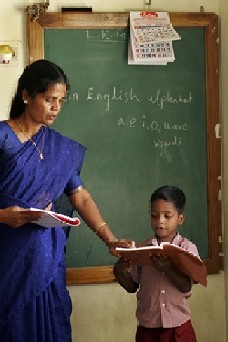About 350 years ago the king in Jaipur built an amazingly accurate observatory complex. It includes large outdoor star maps, moon dials, astrology globes, and this, the world’s largest sundial, accurate to within two seconds. They even knew how many minutes to add or subtract for the time in other parts of India at different times of the year.

The City palace was home to the kings and this part is still occupied by the descendents of the royal family. The tour included a textile exhibit displaying clothing and costumes, with paintings showing the royals who wore them. It also included an armory tour with every sort of weapon that could be imagined for inflicting the wounds of death insomuch that the enemy would become extinct.

Here you see the entrance to the inner courtyard flanked by stone elephants, guards in period costume, and two perky tourists. The floral designs are made with semiprecious stones set in marble, a la the Taj Mahal. Very beautiful craftsmanship. The state of Rajastan and its capital Jaipur are heavily influenced by Turkish and Persian architecture, the result of centuries of Aryan and Turkish invasion and rule. Did you know that “Iran” is a derivation of the word “Aryan?"
Does the man in the red turban have enough charm to pull this off? When I asked about the danger the man said, “No poison.” When I asked about getting bit he said, “Teeth broken out.” It is so difficult to find a manly cobra in its prime these days (except on Rising Star property). On the left is Gabriel Bush, Amy Kirby’s brother, who is volunteering at RSO for several months. A great kid, served his mission in Salvador, Brazil. Any matchmakers out there?

The original old palace and fort can be seen on the hills behind us. The newer palace was built lower down to ease access and to be closer to water. The entire complex has a well-engineered series of cisterns under the courtyards for capturing and storing rain water. Unfortunately, there was never enough water, so the place was abandoned in 1727 and the capital moved a few kilometers to the City Palace in Jaipur.

This “Water Palace” is actually a mosque built to be surrounded by the lake. We visited near the end of the northern monsoon season and it looks like they had a little more rain than was originally planned. All of the stone for the forts, palaces, and mosques was quarried locally through the centuries, as are many of the semi-precious stones used for the art work. Jaipur’s local specialty is garnets.

Jaipur also boasts beautiful textiles. Vickie chose the silk for this new outfit, got measured by the tailor, and picked it up the next day. This north Indian version of traditional dress fits closely around the ankles, as opposed to the loosely fitting ones in the south. The tailor called it a “Punjabi” rather than chuttidhar, the term used in Tamil Nadu. I believe the Hindi term is salwaar kameez.





2 comments:
Mom, I love the pink outfit! I'm loving all your other clothes too:) Sounds like a great tour and some awesome elephant riding too. Thanks for posting, keep it up! (Many more people read it than leave comments...)
Thank you for all your wonderful photos and informtion. I have found a way to print your complete blog and not just the photos. I have gone back and printed them all. Now I have a great binder on life in India. Miss you.
Thanks Again, Kathy Phelon
Post a Comment